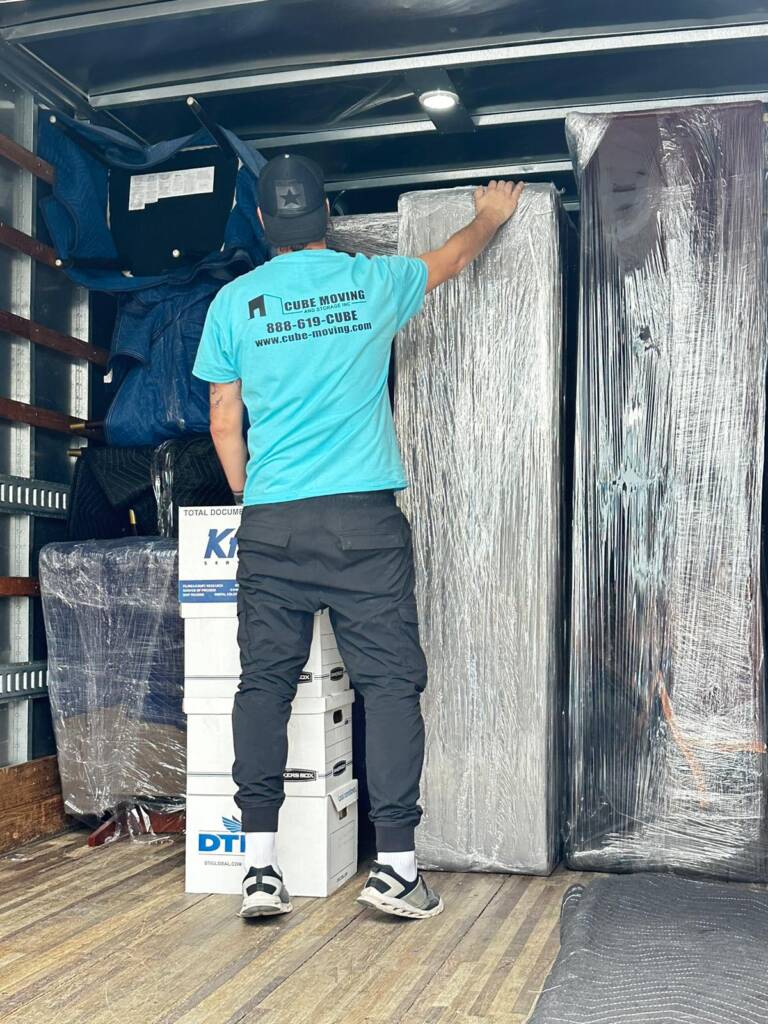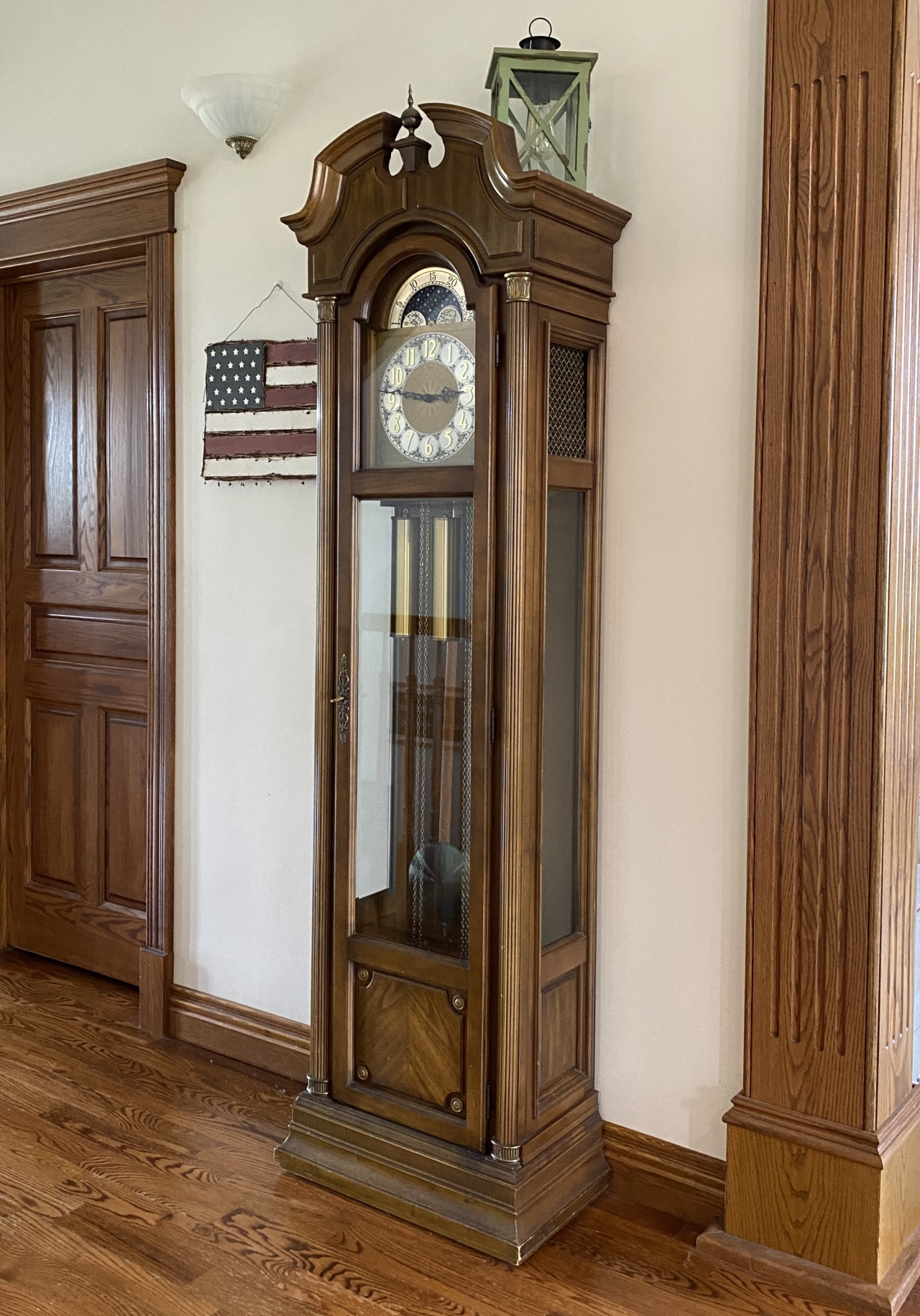How to Move a Grandfather Clock
Moving a grandfather clock is an undertaking that requires meticulous planning and precision. These timeless pieces are not only valuable heirlooms but also intricate mechanical devices that can be easily damaged if not handled correctly, underlining the importance of following a comprehensive step-by-step guide.
It’s about precision and care.
Successfully relocating such an intricate timepiece demands a profound understanding of its components and a delicate touch throughout the process, ensuring that its timeless elegance and function are preserved in your new home.
Preparing Your Grandfather Clock
Note: Addressing Hidden Issues Revealed During the Move Relocating a grandfather clock that has been in the same spot for years can reveal unexpected issues, such as wall discoloration or mold on your walls, caused by limited airflow and prolonged coverage. If you uncover mold during the move, acting quickly is essential to prevent it from spreading and affecting indoor air quality. A professional mold removal company can assess the damage, remove the mold safely, and ensure your home remains a healthy space.
Before the relocation of your revered timepiece commences, thorough preparation is pivotal. Commence by gently stopping the pendulum, securing it to prevent any inadvertent swings that could lead to internal damage. It is advisable to meticulously remove any removable components such as weights and chimes, labeling each part carefully to ensure they are returned to their appropriate place during reassembly. Protecting the glass components with quality padding material is paramount. This initial step safeguards your grandfather clock’s intricate mechanisms, paving the way for a secure and serene transition to its new location.
Securing the Pendulum
The stability of your grandfather clock during transit hinges upon securely immobilizing the pendulum. This component’s suspended action necessitates precise handling to thwart potential disruptions.
The pendulum, orchestrating the clock’s rhythmic poise, must be steadfastly stilled to protect the clock’s harmonious mechanics.
It is essential to gently ease the pendulum from its pivot, wrapping it in plush padding material. This ensures fortification against the jostles and jolts of moving, shielding the delicate fulcrum and its components.
Upon securing the pendulum, confirm that its securing mechanisms are tightly fastened. Comprehensive stability is pivotal—without causing undue strain on the suspension spring—to safeguard the heart of your clock’s temporal precision.
Latching the Weights
Proper latching of the weights is imperative to prevent damage during transportation.
- Identify and mark each weight to ensure accurate reassembly, as they are often weight-specific to their position.
- Secure latches or use strong tape to immobilize the weights, negating any movement.
- Protect with padding, wrapping each weight individually in soft, protective materials.
- Check security of the latch or tape to reaffirm the weights are immobile.
Ensure that each weight is immobilized with meticulous care.
Securing the weights effectively decreases the risk of internal damage, maintaining the grandfather clock’s integrity.
Protecting the Glass Components

The glass panels of a grandfather clock are, undoubtedly, amongst its most vulnerable attributes, requiring a methodical approach to ensure their preservation throughout the relocation process.
Each glass panel must be individually assessed for existing vulnerabilities.
Moreover, precise measurements of each pane should inform the selection of protective materials such as bubble wrap or specialized glass protectors.
Ensuring no direct contact between glass surfaces is essential—utilize cushioning materials like foam sheets or soft blankets to prevent friction.
Implementing a double layer of protection can be instrumental. First, applying a layer of adhesive-free glassine paper shields against scratches; subsequently, a robust outer layer offers impact resistance.
Once encased, glass components should be firmly immobilized within their frames. Consider using painters’ tape, which provides secure hold without leaving residue.
Ultimately, the key to safeguarding your timepiece’s glass is meticulous preparation. Quality protective materials and strategized placement are paramount to ensure each glass element withstands the rigors of transport.
Disassembling the Clock
Prior to transportation, the meticulous disassembly of the clock is imperative. This ensures the integrity of each component remains unscathed during the move.
Begin by gently removing the pendulum using cotton gloves to prevent oil transfer, which can tarnish metal over time. Carefully detach weights and any decorative elements, taking caution to mark their original positions for accurate reassembly.
Finally, stabilize the clock’s internal mechanisms—locking them in place prevents damage from jostling during the move.
Removing the Clock Weights
Carefully label each weight before removal.
Grandfather clocks have intricately calibrated weights that are essential for their operation. Each weight is different and designed for a specific location in the clock, which is why it is crucial to label them before removal. Moreover, failure to do so can lead to confusion during reassembly, as placing a weight in the incorrect position can result in malfunction.
Lower the weights by hand to the base of the clock.
To remove the weights safely, one must – with utmost caution – lower each weight by hand. It is imperative to execute this step delicately to avoid any collision with other clock parts, which could lead to potentially irreparable damage.
Wrap the weights in protective packing.
Each weight should be wrapped individually in bubble wrap or another cushioning material.
When all the weights have been removed and labeled, it’s critical to ensure their protection. Wrap each one in bubble wrap and secure them with tape. In doing so, you insulate these components against potential impacts during transit, preserving the smooth operational ability of your grandfather clock post-move. It’s also advisable to store them in a compartmented box to avoid collision.
Taking Out the Pendulum
Carefully steady the grandfather clock before reaching into its case. It’s essential that you prevent any unintended movements, as even a minor jostle could compromise the pendulum.
Gently secure the pendulum with a soft grip. Make sure not to exert undue pressure which may bend or damage it.
Once firmly in hand, cautiously lift the pendulum off its suspension spring. This part is delicate and demands attention to detail to avoid warping the spring or the pendulum arm. Both components are integral for maintaining accurate timekeeping and overall function.
After the pendulum is detached, it should be wrapped in a non-abrasive protective material, such as felt or a soft blanket, which ensures its preservation from scratches and impacts. Do not use materials that may shed fibers or lint as these can interfere with the clock’s intricate mechanisms upon reassembly. Remember to use a semblance of “cradling” to support and protect the pendulum during its removal.
Detaching any Removable Parts
Before initiating the relocation of a grandfather clock, detach all removable components to prevent potential damage during the move.
- Remove any weights carefully by unlatching them from the pulleys.
- Take out the pendulum to avoid swinging and potential internal damage.
- Unscrew any finials or decorative pieces on the clock’s exterior.
- Extract the side glass panels if they are not soldered or permanently affixed.
- Keep all small parts and hardware in clearly labeled bags for easy reassembly.
Handling each part with care is critical to maintaining the integrity of the clock.
Properly preparing the removable parts for transit is as crucial as the disassembly itself. Each component must be safeguarded with appropriate packing materials to ensure their protection during the move.
Packing and Cushioning
Efficient packing is paramount when it comes to safeguarding the grandfather clock’s components. Utilize high-quality, acid-free packing paper and bubble wrap to enfold each piece, ensuring ample cushioning against jolts and vibrations that could occur during transit. Delicate items like the movement and the weights require extra attention; secure them within resilient, yet accommodating materials such as foam padding or specialized clock moving blankets. Confirm that these elements are stably positioned in the packing container, exercising caution to avoid shifting which could invite harm. Precision in packing is a meticulous task, but it is instrumental in preserving the clock’s grandeur for future generations.
Wrapping Individual Components
The pendulum should be enveloped with a soft cloth first, to provide an initial layer of protection against scratches and friction.
When wrapping the weights, identify and mark them according to their designated position within the clock mechanism, to ensure accurate reassembly. It’s advisable to surround each weight with bubble wrap, securing the material with high-grade packing tape. This encasement needs to be firm to prevent unwarranted movement, yet not too tight as to deform the soft metal. Remember to cushion the bottom of the box before placing the weights inside, to absorb any potential impacts.
Weights are often sheathed in ornate shells that must be treated with particular caution. After wrapping the core weight in bubble wrap, add an extra layer around the decorative casing to guard against any blemish or deterioration. This double wrap technique provides a robust defense against the trials of transport.
The movement, being the lifeblood of the clock, demands vigilant care. Fragment each section of the movement with proper padding, using high-quality material that is less likely, under duress, to generate abrasive residues which could penetrate and impair the delicate inner workings. Ensuring these components are snugly fitted within sturdy, compartmentalized boxes mitigates the risk of errant displacements or collisions that could result in irreversible damage, maintaining the precision of the timepiece post-relocation.
Box Selection and Packing Technique
Choosing the right box for a grandfather clock is crucial; it must be durable and size-appropriate to accommodate various components securely. Select double-corrugated cardboard boxes that offer superior protection and rigidity to withstand the stresses of transportation.
Select boxes with a snug fit to prevent movement and shifting. Too much space can be detrimental.
For the clock’s delicate glass elements, a bespoke crate made of wood may be the optimal solution. The sturdy material provides structural integrity and shields against high-impact scenarios that cardboard cannot withstand. Custom crating ensures an unmatched level of protection tailored to the unique dimensions and vulnerabilities of the grandfather clock’s glass.
When packing the clock into the chosen box or crate, it is essential to observe attentive padding around each component. Utilize specialized packing materials such as foam inserts that conform to the shape of the parts, providing a buffering zone which is imperative to prevent abrasion and jarring. Furthermore, secure the packing with high-tensile-strength strapping tape to maintain the positioning of the protective materials, even when subject to varied orientations and movements during transit. Remember, the goal is to immobilize the components within the confinements of the packaging to nullify the chances of internal movement and consequent damage.
Labeling and Handling Instructions
Precise labeling is indispensable for safeguarding your grandfather clock during relocation. Ensure that all packaging is clearly marked with essential information such as “Fragile,” “This Side Up,” or “Handle With Care” to forewarn movers of the delicate nature contained within.
Such designations serve as critical notifications for all personnel involved in the transportation process, guiding their actions when handling your prized possession. It’s imperative that these indicators are conspicuous and placed on multiple sides of the packaging for optimal visibility.
Complementing the external labels, internal packing list documentation is equally crucial. This should itemize every enclosed component, facilitating accountability and enabling precise reassembly upon arrival at the destination. Furthermore, include specific handling instructions that cater to the fragility and structural nuances of the grandfather clock’s components.
Movers should also be verbally briefed on the importance and correct manner of transporting your grandfather clock. This is vital for reinforcing the visible labels and ensuring that all individuals exercise caution and follow proper lifting techniques to prevent undue strain or damage.
Finally, inspection upon delivery is a non-negotiable step. This ensures that you promptly identify any potential discrepancies or issues that may have occurred during the moving process, allowing for immediate action and resolution.
Safe Transportation and Setup

Upon reaching its destination, the grandfather clock requires meticulous handling to ensure its structural integrity and operational functionality are preserved. Carefully maneuver the clock from the transportation vehicle into its new environment, avoiding sudden jolts or tilts. Establish the clock in a stable, level position, engaging experts if necessary to fine-tune the balance for precise timekeeping. Before fully activating the clock, conduct a thorough inspection to confirm that all components are intact and the movement is unobstructed, ensuring the rhythmic longevity synonymous with such time-honored horological masterpieces.
Moving the Clock Safely
Handle with extreme delicacy and foresight.
Moving a grandfather clock is a delicate process that requires systematic precision and care. Such timepieces are not only valuable but often hold sentimental worth, thus necessitating a cautious approach. It is imperative to disassemble the clock carefully, paying close attention to manufacturer guidelines and intricacies of the clock’s mechanism. Furthermore, stabilizing the weights and pendulum is essential to mitigate the risks associated with transport.
Utilize special packaging for components.
Each element must be immobilized effectively – use padding and wrapping to protect each piece during the move. It’s vital to collaborate with professionals to leverage their expertise, particularly for handling the clock’s intricate mechanism and ensuring the structural integrity. A professional moving team possessing clock-specific experience should be consulted to guarantee safe handling during transit.
Position the clock upright at all times.
While in transit, the clock must remain upright to maintain its alignment and prevent internal damage. Employing skilled movers with the right equipment is crucial to avoid compromising the clock’s intricate systems. Forward-planning for the journey in 2023 requires meticulous route optimization to minimize the risks during transportation, influencing factors such as road conditions and vehicle stability which can affect the safe delivery of your heirloom.
Reassembly on Arrival
Upon safe arrival, methodical reassembly of the grandfather clock is paramount. First and foremost, assess the space where the clock will be placed, ensuring that it is both level and free of environmental factors that may impact the clock’s future performance.
After establishing a suitable location, begin the reassembly process by carefully reinstalling the clock’s base. It is paramount to lay a stable foundation to prevent any potential imbalance that could adversely affect the clock’s movement. Assure that the base is level before attaching the weights and pendulum, elements that are essential for accurate timekeeping and proper mechanical function.
Next, proceed to the clock’s body, focusing on the alignment of its components. Connect the body to the base with precision, avoiding any force that might misalign the gears or mechanism. Patiently work to secure the body, ensuring that all fastenings are tightened to the correct specification to maintain the structural integrity of the clock.
Finally, the moment to reattach the clock’s face and hands arrives. Approach this task with an attentive eye for detail, aligning the hands correctly to ensure they move freely without obstruction. Once in place, initiate the movement, checking for any irregularities in function. Should you encounter issues during this complex process, do not hesitate to consult a horologist to ensure the ancestral timepiece resumes keeping time with accuracy and elegance.
Post-Move Clock Adjustment
After stabilizing the grandfather clock’s position, the clock’s regulator should be carefully adjusted to ensure precise timekeeping once again.
Once the clock has been reassembled and stabilized, it’s crucial to evaluate the swinging motion of the pendulum, ensuring it’s moving with an even and consistent rhythm. This pendulum swing, known as the beat, must be perfectly even for the clock to keep accurate time. Any irregularities could indicate that the clock is not perfectly level or that internal adjustments are necessary. This might include lateral adjustments to the crutch, which holds the pendulum, to ensure it swings with an equal arc on each side.
In addition, attention should be directed to the synchronization of the chimes or strikes. These auditory signals are markers of time and should correspond accurately with the displayed time. If the chimes are not synchronized with the time on the clock face, careful adjustment of the hour hand or the striking mechanism may be needed.
For those seeking impeccable precision, fine-tuning may involve calibrating the timekeeping against an external standard, like an atomic clock or a GPS-based time signal. This is particularly important if the clock indicates seconds, as even small deviations can accumulate rapidly. Calibration is a delicate process and may necessitate the expertise of a horologist, particularly when dealing with antique or complex mechanisms that demand a refined touch and specialized knowledge.





Leave A Comment